-
36% of Spanish adults are fine with an algorithm selecting what news to show them based on what they have consumed, but only 30% agree with agreement that it is decided by editors and journalists.
-
One in five users (20%) approve of the fact that the selection publishing house of news presented to them is based on what their friends have consumed.
-
Three out of ten users try to change what the algorithms show them, in search of more reliability, pluralism and interest, over positivity or fun.
The platforms where we consume news tend to personalize the information we receive, from agreement with our interests, in order to increase the time of use of each Username and their interaction with the content. Not only in those owned by technology companies and combining several sources, but also, increasingly, in the websites and apps of the journalistic media themselves, where users are encouraged to browse with a logged-in session. At the same time, the work of intermediation, selection and hierarchization of information carried out by journalists, applying a general criterion publishing house for the audience as a whole, is called into question by the growing tendency to voluntarily apply filters, or based on their behavior and that of the audience in general, to prioritize certain topics and ways of presenting them over other news and points of view, which are relegated to the background.
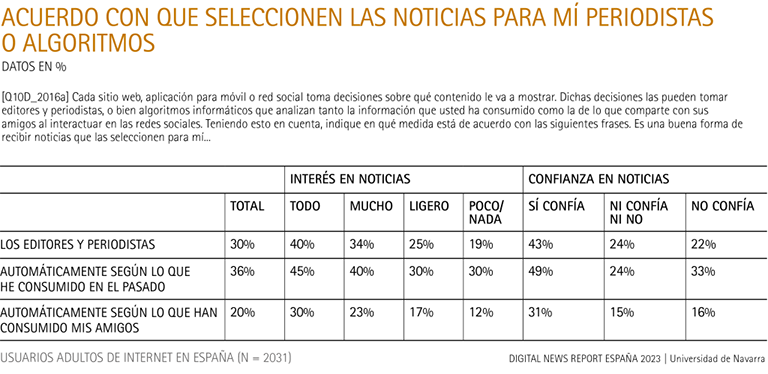
30% of Spanish adults connected to the Internet agree agreement with the selection of news by professional editors and journalists, and consider it a good way to be informed, compared to 29% who are against the news being filtered in this way, and 41% who neither sample agreement or disagree. Therefore, there is a balance between supporters and detractors of the mediating role of journalism in terms of setting the diary information (what topics the media cover). Nevertheless, and at the risk of drawing a hasty conclusion, this ambivalence about one of the most basic functions of professionals and organizations dedicated to informing could suggest an important social skepticism about the basic editorial processes with which journalistic companies that offer a hierarchical and closed product to the general audience operate.
The presentation of informative content to each Username according to their previous consumption obtains greater acceptance, with 36% of agreement, compared to 26% of disagreement, with 38% of Spanish adults indifferent. On the other hand, the selection of information by algorithmic recommendation based on the behavior of the users' contacts or "friends" is rejected by twice as many respondents (38%) compared to those who agree agreement that the news they receive sample should be selected in this automated and "social" way.
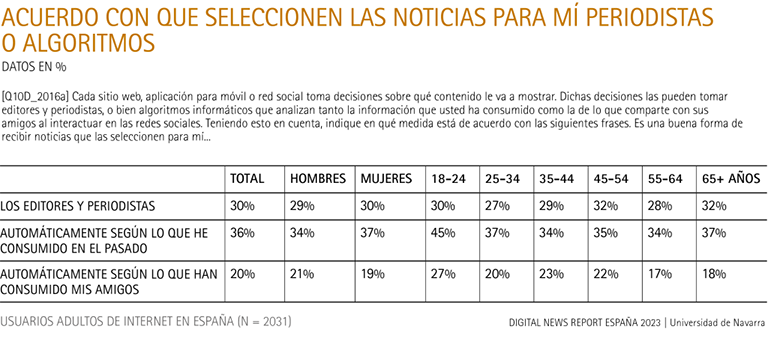
The order among the three modalities remains the same among men and women and in the different age groups, with a predominance of the recommendation by history over the criteria publishing house of journalists and editors, although the selection of news according to previous consumption (45%) and the formulas based on the activity of the contacts of Username (27%) are particularly popular among people between 18 and 24 years of age.
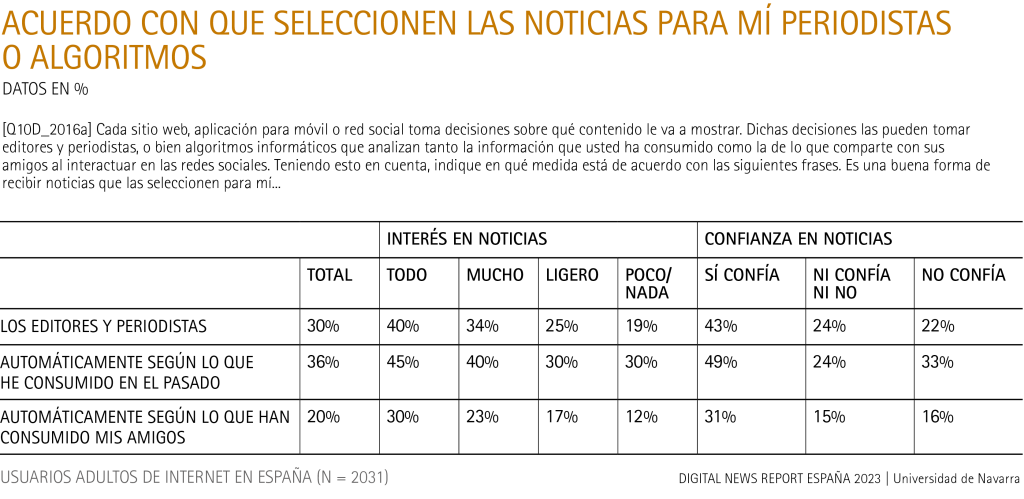
Likewise, when segmenting by interest or confidence in news, the order of preference among the different forms of selection offered to Username is maintained in all cases. The greatest variation is found in the role assigned to journalists and editors: while those very or totally interested in news approve of this professional selection task by 40%, among those with little or no interest it barely reaches 19%.
Among those who trust the news, there is greater approval of all types of news selection, in a proportion approximately one third higher than that of average: by history of use (49%), by criteria publishing house of journalism professionals (43%) and by the behavior of their contacts (31%). On the other hand, among those who have a neutral or negative position regarding trust in news, there is less approval than average regarding the three selection criteria: they show their approval of the selection work of journalists and editors... slightly less than one in four users who do not clearly trust the news.
The risk of being left out of news and opinions that are not to one's liking
Fifty-six percent of adults in Spain fear missing out on important information that may be hidden from them due to the personalization of the news they receive, with fairly homogeneity by gender and age, but there are important differences between those who are totally or very interested in the news, among whom it rises to 63%, and those who are not interested, of whom only 37% are concerned. There are also different results between those who trust (68%) and those who distrust (55%) the news in general.
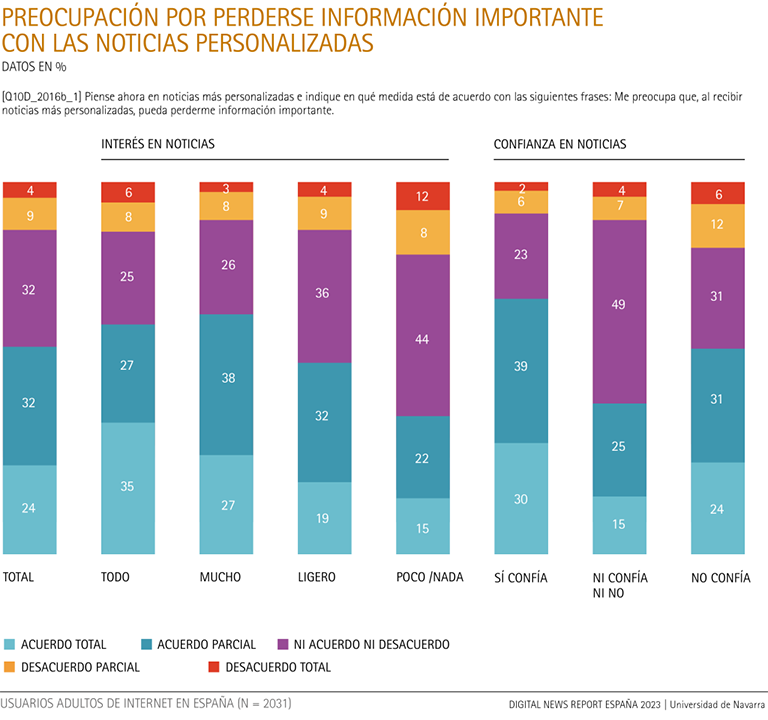
Similarly, 50% of adults are concerned about missing points of view contrary to their own due to the personalization of the information they access through the Internet, equally homogeneously between men and women and by age, but there are large differences between those who are totally or very interested in the news (60%) and those who are less or not at all interested (34%), and also between people who trust (62%) and those who distrust (50%) the news in general.
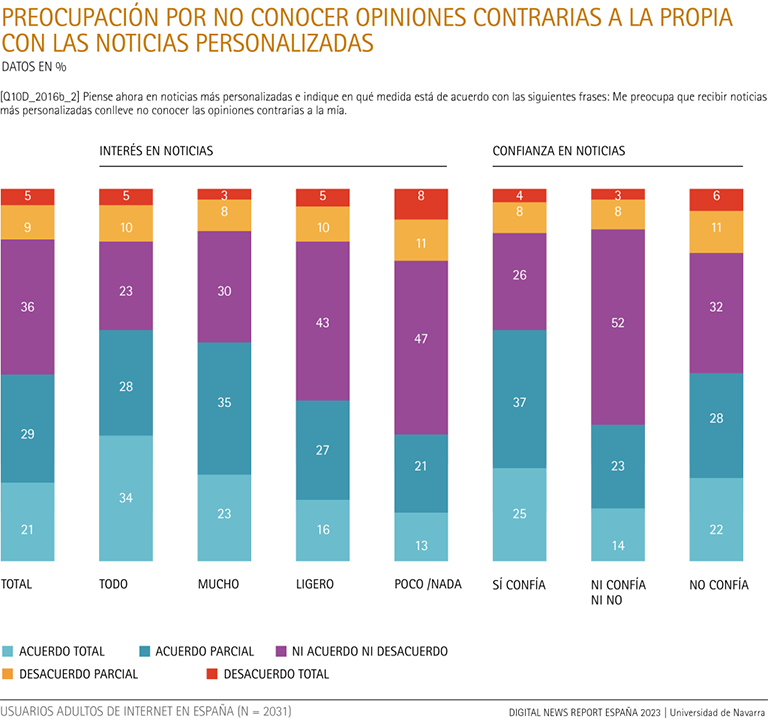
How much and for what purpose it is intended to adjust what sample algorithm
Faced with the personalization offered by algorithms, survey asked how often users try to change the news and information they see on online platforms, with actions such as following or unfollowing new profiles, muting or blocking others, or changing other options. Nine percent do it often, 29 percent do it often or sometimes, and 65 percent do it at least occasionally, compared to 16 percent who never do it and 11 percent who say they do not use the platforms that allow them to do so for information purposes.
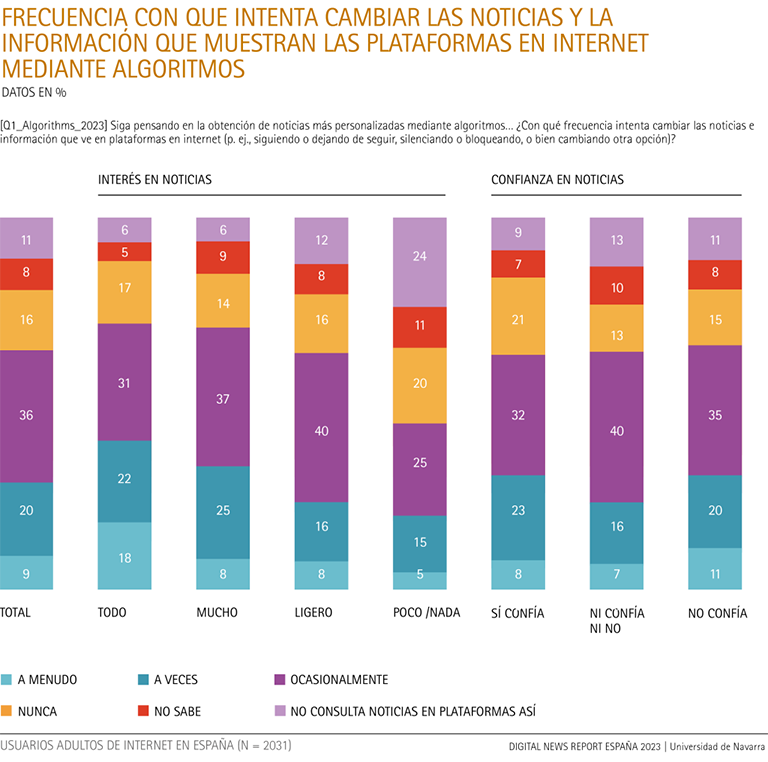
In this case, there are no major differences between the different groups according to trust in the news, although greater interest in the news also determines greater user activity in adjusting what the algorithms show them. People totally or very interested adjust often or sometimes by 35%, and among those not or not at all interested this behavior only occurs with that frequency in 20%. Additionally, another 36% of very or totally interested people do it occasionally (totaling 71%), compared to 25% of those who have little or no interest (which, added to those who do it more frequently, are at 45% in this group of the least interested). Also, older people carry out these activities less frequently, and a higher percentage do not use these platforms with personalization (16% of those over 55, compared to 8% of adults under that age).

In this case, the responses refer only to those who say they have performed these actions on the platforms in the previous answer. The most popular objectives are those that can be considered more desirable: that the content users receive is more reliable (43%) and to see more varied perspectives and points of view (38%), as well as that the news received is more interesting (32%) and to see less toxic content (30%). Other reasons that can be related to the rejection of some types of less pleasant or entertaining news are in the last places: seeing less negative or depressing content (21%) and encountering more amusing news (14%).
Significantly more people aged 55+ make adjustments to what algorithms show them in order to get more reliable content: this is 52% (specifically, 54% in the 55-64 age bracket), which puts them almost ten points above all adults (43%), and is more than a dozen percentage points higher than the other age brackets (36-39%).
There are also significant differences, compared to other age groups, in the number of 18-24 year olds whose aim is to see less negative or depressing content: 29%, which is eight percentage points more than any other age group. Even greater is the age difference in adjusting algorithms to show funnier content: 20% of 18-24 year olds do so, compared to 10% of 55+ year olds.